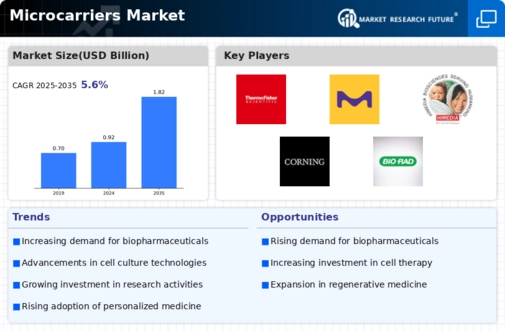Market Trends
Key Emerging Trends in the Microcarriers Market
In recent years, the microcarriers market has experienced significant growth and transformation, fueled by a variety of market trends and technological advancements. One notable trend is the increasing adoption of microcarriers in cell culture processes across various industries, including biotechnology, pharmaceuticals, and regenerative medicine. Microcarriers provide a three-dimensional substrate for cell growth and proliferation, offering advantages such as higher cell yields, scalability, and cost-effectiveness compared to traditional two-dimensional culture methods. As a result, there is growing demand for microcarriers as a platform for large-scale production of cells for therapeutic applications, driving market expansion.
Another key trend in the microcarriers market is the development of novel materials and surface modifications to enhance cell attachment, proliferation, and differentiation. Researchers and manufacturers are exploring a wide range of biomaterials, including polymers, ceramics, and hydrogels, with tailored physicochemical properties to optimize cell-microcarrier interactions. Surface modifications such as extracellular matrix coatings, peptide functionalization, and nanoparticle incorporation further improve the performance and functionality of microcarriers, enabling precise control over cell behavior and phenotype in culture systems.
Furthermore, there is a growing focus on the application of microcarriers in the production of advanced cell therapies, including stem cell-based therapies, tissue engineering constructs, and cell-based vaccines. Microcarriers provide a versatile platform for the expansion and differentiation of therapeutic cells, enabling the generation of large quantities of cells with desired characteristics for clinical use. Advances in cell culture media formulations, bioreactor design, and process automation are facilitating the scale-up and commercialization of cell therapies, driving demand for microcarriers as an essential component of manufacturing workflows.
Additionally, the microcarriers market is witnessing increased adoption in the field of bioprocessing and biomanufacturing, driven by growing demand for biopharmaceuticals and recombinant proteins. Microcarriers serve as carriers for anchorage-dependent cell lines used in the production of therapeutic proteins, monoclonal antibodies, and viral vectors. By enabling efficient cell growth and protein expression in suspension culture systems, microcarriers help streamline bioproduction processes, reduce production costs, and accelerate time-to-market for biologics. As a result, biopharmaceutical companies and contract manufacturing organizations are investing in microcarrier-based technologies to meet the growing demand for biologics worldwide.
Moreover, there is a trend towards the customization and optimization of microcarrier formulations and manufacturing processes to meet specific application requirements and regulatory standards. Manufacturers are collaborating with researchers and end-users to develop tailor-made microcarrier solutions for specific cell types, culture conditions, and therapeutic applications. This customization enables precise control over critical parameters such as cell attachment, growth kinetics, and product quality attributes, ensuring reproducibility and consistency in cell culture processes. Furthermore, efforts to standardize manufacturing processes and quality control protocols are driving greater adoption of microcarriers in clinical and commercial biomanufacturing applications.


















Leave a Comment